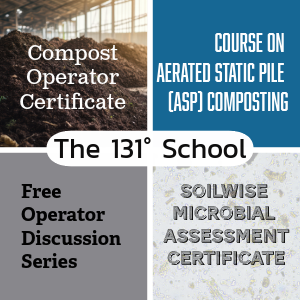To help remediate Florida’s Indian River Lagoon — the most biologically diverse estuary in North America — an algal treatment system was installed, with algae harvested and composted.
Molly Farrell Tucker
BioCycle May 2014
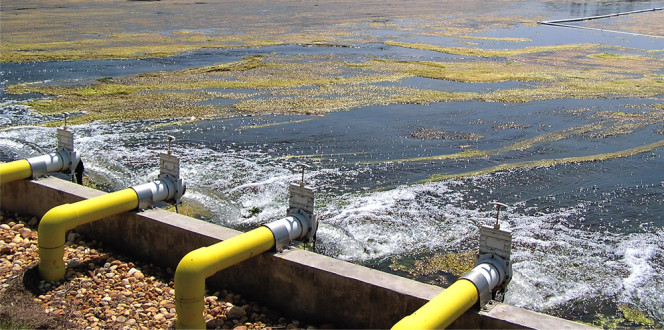
An Algae Turf Scrubber (ATS) system cleans polluted water from the Lateral D Canal by pumping it over a sloping surface. Algae in the water attach to the ATS surface and grow, removing nutrients and other pollutants.
Florida’s Indian River County is using composting and other innovative water treatment technologies to rehabilitate a section of the 154-mile long Indian River Lagoon. The Lagoon is the most biologically diverse estuary in North America, running along the eastern coast of Florida, just north of New Smyrna Beach and south to the northern limits of Palm Beach County. Indian River County’s portion of the lagoon is approximately 22 miles long.
The pollution in the Indian River Lagoon began over 80 years ago, when three large canals were built to drain more than 50,000 acres of marshland in order to make the land usable for farming and commercial development. The canals drain directly into the Indian River Lagoon, discharging huge quantities of storm water runoff and groundwater seepage. The runoff and seepage contain nitrogen and phosphorus from fertilizers used on agricultural land and residential developments. These nutrients then fertilize freshwater aquatic plants growing in the canals.
Tons of freshwater plants in the canals were traveling into the lagoon each year. The freshwater plants would die off from the saline environment in the lagoon and fall to the bottom, creating a muck of decaying organic matter. The nitrogen and phosphorus created algae blooms. The blooms and suspended solids hinder sunlight from getting into the water, which seagrass needs to survive in the lagoon. Seagrass is necessary for food and refuge for many species of aquatic life. Too much algae can lower oxygen levels in water and kill fish, crustaceans and other aquatic life.
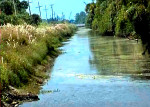
Excess nutrients in storm water runoff and groundwater seepage fertilize freshwater aquatic plants growing in the canals. These plants travel into the Indian River Lagoon, disrupting the ecosystem.
This not only poses a threat to the ecological diversity of the lagoon, but also to the local economy. Indian River County commissioners describe the lagoon as the economic engine that fuels the counties that border it. “We have an outdoor recreation and tourism based economy,” says Indian River County Commissioner Peter O’Bryan. “We have a lot of businesses dependent on a healthy Indian River Lagoon so we needed to be proactive to remove the dangerous nutrients that enter this waterway. If we don’t keep the lagoon healthy, we are going to lose all that.”
The Solution
To address the situation in the canal, Indian River County requested bids in 2008 to construct a 35-acre Egret Marsh Stormwater Park to treat water from the Indian River Farms Water Control District’s Lateral D Canal. H&D Construction Co., Inc. of Okeechobee was selected as the general contractor. The facility included construction of an Algae Turf Scrubber (ATS) system, which cleans polluted water by pumping it over a sloping surface. Algae grows on the surface, removing pollutants from the water. The algae is collected and composted, and the water is further treated in polishing ponds before being released into the canal system that leads to the lagoon. “The algal turf scrubber was compared with chemical injection and a passive wetland system,” says Keith McCully, P.E., an engineer who helped design Egret Marsh Stormwater Park. “The algal turf scrubber showed the lowest cost after a net present worth analysis.”
HydroMentia of Ocala, Florida, founded in 1996, held the patent for the ATS system. HydroMentia worked with Indian River County to design and permit the system, which is located on nearly five acres within the Egret Marsh park and includes the 575-foot by 348-foot ATS pad, two solids ponds, three polishing ponds, a composting pad and a habitat area for endangered wood storks. Construction started in December 2008 and the facility opened in April 2010. Capital costs were around $6 million. Todd Tardif, the senior storm water inspector and enforcement coordinator for Indian River County is in charge of its day-to-day operations.
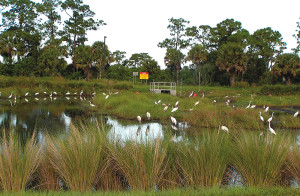
Water from the polishing ponds flows into the 3-acre Wood Stork Habitat, where many species of birds have been sighted. Clean water from the habitat then flows via canals into the lagoon.
Water Collection And Treatment
The Egret Marsh facility diverts an average of 8 to 10 million gallons of water every day from the Lateral D Canal. The canal water is pumped underground for more than 600 feet to the ATS system’s headworks structure, a concrete tank containing an influent box and a surge distribution box. The water flows into the influent box, which contains a flow-measuring weir, then into the surge distribution box that contains a surging device, and then out over the Algal Turf Scrubber pad. The polluted water flows in surges over the pad through a series of adjustable valves at the front end of the pad. “Algae in the water attaches to the ATS surface and as the algae grows, it removes nitrogen, phosphorus and some trace elements from the water,” explains McCully.
The ATS pad initially had a plastic geomembrane that was covered with a rough, grid-like mesh. “We took the geomembrane and mesh out in the fall of 2011 because they were failing,” says Tardif. “We replaced it with a poured concrete pad and put a rough finish on it.” Water on the pad flows about 1.0 to 1.5-inches deep. He notes that he is in constant communication with the Indian River Farms Water Control District regarding canal water elevations, aquatic weed spraying, and other events that might affect algae growth at Egret Marsh. “We have the benefit of a backup pump,” he notes. “If we have to shut the Lateral D Canal pump down because of low water levels or aquatic weed spraying, we can pump water from our large polishing pond.”
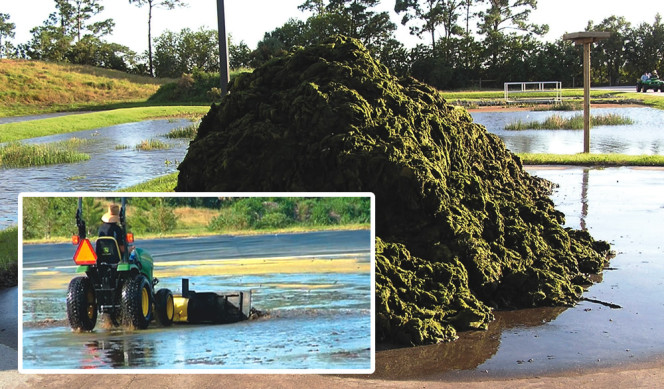
A tractor outfitted with a custom-made blade design harvests the algae (inset), which is then removed with a harvest rake and put on an asphalt pad.
It takes two weeks for the algae to grow large enough to be harvested again after the prior harvesting event. Tardif, with assistance from McCully and Alexis Thomas, the County’s storm water educator and fertilizer enforcement officer, may harvest over 100,000 wet pounds of algae every Thursday. “Only half of the algae field is harvested at a time in order to keep a relatively mature algae crop on at least one-half of the surface at any time,” explains McCully.
The algae is harvested with a tractor outfitted with a custom-made blade designed by Tardif. A strip of rubber on the bottom of the blade sheers algae from the pad but leaves some of the plant behind. “I went through several blades, but I’m really happy with this one,” he says. “Part of the material on the blade is from a snowplow company in Michigan. When I placed the order the sales person asked why I need a snowplow in Florida!”
Harvested algae is pushed to the end of the ATS pad and into an effluent flume at the other end of the pad where it is picked up by a self-cleaning harvest rake made by Duperon Corporation. The dirty algae harvest water flows into one of two solids ponds where solids settle out.
Composting Process
The algae is combined with a carbon source and composted outdoors on an asphalt pad that is a little more than a quarter-acre in size. For carbon sources, the county’s Road and Bridge Division brings extra yard trimmings from maintaining county right-of-ways. “When possible, we also purchase mulch from the County’s landfill,” says Tardif. He uses a Daewoo skid-steer loader to load and spread the harvested algae and carbon sources onto the compost pad. The materials are formed into rows and flipped once a day for the first five days with a Brown Bear aerator that hooks onto the front of the Daewoo. “The aerator has a bunch of teeth that rips the pile apart,” he explains. “It’s like a snow plow on steroids.”
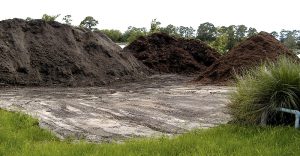
Harvested algae is mixed with yard trimmings and/or mulch and formed into piles. A Brown Bear aerator is used to turn the piles for the first five days of composting.
The pile is composted for 30 days and then turned again. Once the temperature reaches 140°F, material is moved into a final pile for 60 to 90 days. A trommel screen separates some of the finished compost. “We’re looking at bagging and selling it as high quality compost,” says Tardif. Indian River County has contracted with Van Ert-Nemoto and Associates, led by scientist Matthew Van Ert, PhD, to assist in getting the composted algae into the commercial market. “We have had the product tested by the US Composting Council Seal of Testing Assurance program and it was rated as excellent,” says McCully.
Final Water Treatment
After leaving the ATS, the water moves through a polishing pond system, which is 15- to 20-feet deep and several acres in size. The polishing ponds are designed to remove algae that may have escaped the harvest rake. The water then flows into the 3-acre Wood Stork Habitat. Many species of birds have been sighted there, including Sandhill cranes, egrets and ducks, Canada geese, eagles, hawks and sandpipers and dozens of wood storks. The habitat is also home to alligators and a variety of fish, including bass and tilapia. Clean water from the habitat then flows into the Lateral C Canal, into the Main Relief Canal and into the Lagoon. “It would take 150 to 200 acres of regular manmade marshland to accomplish the same thing that we do on five acres,” notes Tardif. “It’s Mother Nature at her best.”
The County is constructing a second ATS system called Osprey Marsh on Fifth Street SW in Vero Beach that is expected to be operational in Fall 2014. That facility will mix polluted water from the South Relief Canal with brine water (a by-product of reverse osmosis water treatment) produced from the South County Water Treatment Plant in Vero Beach. Algae grown there will be transported to Egret Marsh for composting. “There won’t be enough room at Osprey Marsh for composting,” says Tardif. He expects that this will double the amount of algae currently being composted at Egret Marsh, and estimates that over 100 tons/year of compost will be produced.
Molly Farrell Tucker is a Contributing Editor to BioCycle.











